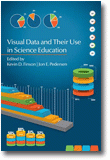
Visual Data and Their Use in Science Education
Edited by:
Kevin D. Finson, Bradley University
Jon Pedersen, University of South Carolina
Published 2013
Visual Data in Science Education builds upon previous work done by the editors to bring some definition to the meaning of visual data as it relates to education, and highlighted the breadth of types and uses of visual data across the major academic disciplines. In this book, the editors have brought this focus specifically to science education through the contributions of colleagues in the field who actively research about and engage in teaching with visual data. The book begins by examining how the brain functions with respect to processing visual data, then explores models of conceptual frameworks, which then leads into how related ideas are actuated in education settings ranging from elementary science classrooms to college environments. As a whole, this book fosters a more coherent image of the multifaceted process of science teaching and learning that is informed by current understandings of science knowledge construction, the scientific enterprise, and the millennium student as they relate to visual data.
CONTENTS
Foreword, Gayle A. Buck. Introduction, Kevin D. Finson and Jon E. Pedersen. Reviewers. SECTION I: BRAIN FUNCTIONING AND CONCEPTUAL CHANGE. The Role of Visualization in Conceptual Learning and Conceptual Change, O. Roger Anderson and Julie Contino. A Cognitive Perspective on Conceptual Change in Science, Crystal Bruxvoort and James Jadrich. Applying Vosniadou’s Conceptual Change Model to Visualizations on Conceptions of Scientists, Kevin D. Finson and Donna Farland-Smith. Reconsideration of the DASTT-C, Nathan G. Carnes. SECTION II: PRESERVICE SCIENCE TEACHER PREPARATION AND VISUAL DATA. Education Rather than Training: Cognitive Pluralism and Preservice Science Teacher Education, Joanne K. Olson. Using Visual Data to Investigate Influences on Preservice Teachers’ Attitudes about Scientists, Christine D. Tippett and Todd Milford. SECTION III: USING VISUAL DATA WITH SCIENCE STUDENTS. Innovations in Computer-Based Simulations to Promote Science Learning, Fernand Brunschwig and Lea B. Accalogoun. A Comprehensive Literature Review on Students’ Conceptual Understandings Enhanced Through Technology Instruction, Kathy Cabe Trundle and Mesut Saçkes. Revealing Data in Science: Using and Teaching About Data-Based Graphics for Analysis and Display, Anne E. Egger and Anthony Carpi. Learning to Do Geospatial Data Visualization in Science Classrooms, Josh Radinsky, Jennifer Mundt Leimberer, and Carlos Rodriguez. Optimizing “Super Graphics” for Effective Informal Scientific Visualization Displays, Renee M. Clary and James H. Wandersee. Theory, Practice, and Challenges for Teaching Visual Literacy in Science: Through the Lens of Content Area Literacy, Erin M. McTigue and Julianne M. Coleman. Exploring the Use of Visual Data to Uncover Science Students’ Conceptions of an Engineer and Engineering, Brenda M. Capobianco and Stephen L. Thompson.
-
Paperback9781623962043
Web price: $45.04 (Reg. 52.99)
-
Hardcover9781623962050
Web price: $80.74 (Reg. 94.99)
- eBook9781623962067

- EDU010000 - EDUCATION: Elementary
- EDU024000 - EDUCATION: Reference
- EDU029030 - EDUCATION: TEACHING METHODS & MATERIALS: Science & Technology
-
 Contemporary Perspectives Through Action Research Across Educational Disciplines
The K-12 Classroom
Contemporary Perspectives Through Action Research Across Educational Disciplines
The K-12 Classroom
-
 Continuous Improvement
A Leadership Process for School Improvement
Continuous Improvement
A Leadership Process for School Improvement
-
 Digital Technologies and Early Childhood in China
Policy and Practice
Digital Technologies and Early Childhood in China
Policy and Practice
-
 Structured Discovery Cane Travel Approach to Orientation and Mobility Concepts
Structured Discovery Cane Travel Approach to Orientation and Mobility Concepts
-
 Supporting Leaders for School Improvement Through Self-Care and Wellbeing
Supporting Leaders for School Improvement Through Self-Care and Wellbeing
-
 The Internationalization of Higher Education
Concepts, Cases, and Challenges
The Internationalization of Higher Education
Concepts, Cases, and Challenges
-
 Unveiling the Cloak of Invisibility
Why Black Males are Absent in STEM Disciplines
Unveiling the Cloak of Invisibility
Why Black Males are Absent in STEM Disciplines

